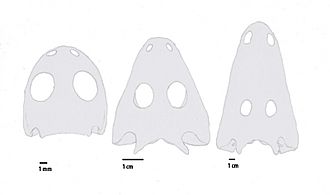Warrenisuchus facts for kids
Quick facts for kids Warrenisuchus |
|
|---|---|
 |
|
| Skulls at various ontogenic stages | |
| Scientific classification |
|
| Kingdom: | Animalia |
| Phylum: | Chordata |
| Order: | †Temnospondyli |
| Suborder: | †Stereospondyli |
| Clade: | †Capitosauria |
| Genus: | †Warrenisuchus Maganuco et al., 2009 |
| Type species | |
| †Warrenisuchus aliciae (Warren and Hutchinson, 1988) (originally Parotosuchus aliciae)
|
|
Warrenisuchus is an extinct type of amphibian that lived a very long time ago, during the Early Triassic period. This was about 250 million years ago! Its fossils have been found in Queensland, Australia. Warrenisuchus belongs to a large group of ancient amphibians called Capitosauria.
The main species, Warrenisuchus aliciae, was officially named in 2009. Before that, it was thought to be a species of another amphibian called Parotosuchus. Fossils of Parotosuchus have been found in places like Europe, Africa, and Antarctica. Later, in 2000, W. aliciae was briefly placed in a new group called Rewanobatrachus. However, scientists later decided that Rewanobatrachus was not a valid name, so W. aliciae got its own group, Warrenisuchus. Some studies still suggest that Warrenisuchus aliciae might actually be a type of Watsonisuchus. What makes Warrenisuchus special is that we have found many small, young skulls, unlike most other capitosaurs.
What Did Warrenisuchus Look Like?
Scientists have found several fossil pieces of Warrenisuchus. The most important fossil, called the holotype, includes most of the skull, lower jaws, shoulder bones, some backbones and ribs, and part of a back leg. Another fossil, called the paratype, has a partial skull and shoulder bones.
All the known Warrenisuchus fossils are quite small. The largest skull found is only about 3.9 centimeters (about 1.5 inches) long. The smallest is even tinier, at 1.1 centimeters (less than half an inch) long. To give you an idea, adult capitosaurs could have skulls over a meter (more than 3 feet) long!
These small sizes, along with other features, tell us that most of the Warrenisuchus fossils we have are from young amphibians. Young Warrenisuchus had large eye sockets and rounded heads. Adult capitosaurs usually had more triangular heads. Their skull bones were also loosely connected, which is common in young animals. They had small tabular horns (small bumps on the back of the skull) and a special opening called a pineal foramen (for a light-sensing organ) that was close to their eyes. In adults, this opening would be farther back.
The very smallest fossils seem to be from the stage right after they changed from tadpoles into young amphibians. At this point, they had lost their gills, and their skull bones had started to get thicker, but their backbones were still developing.
Where Did Warrenisuchus Live?
The fossils of Warrenisuchus are the most common amphibian fossils found in eastern Australia from the Early Triassic period. They were preserved in a rock layer called the Arcadia Formation. This formation dates back to a time called the Induan stage.
Other types of ancient amphibians found in the Arcadia Formation include rhytidosteids and brachyopoids. At the same time, in western Australia, there was another group of amphibians. This group had more types of brachyopoids, along with rhytidosteids, trematosaurids, and another capitosaur called Edingerella. Interestingly, Edingerella was a close relative of Warrenisuchus.
Images for kids


